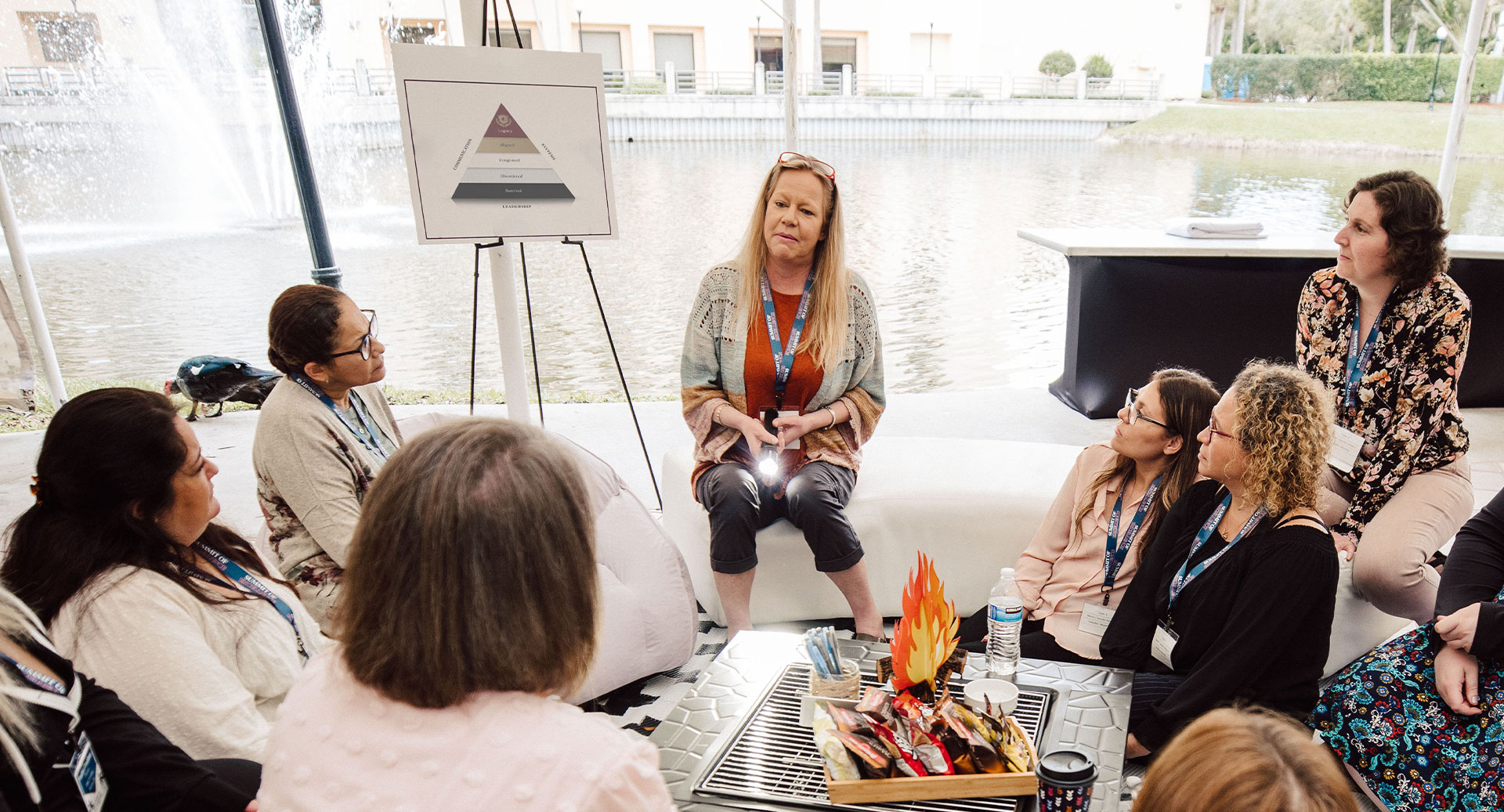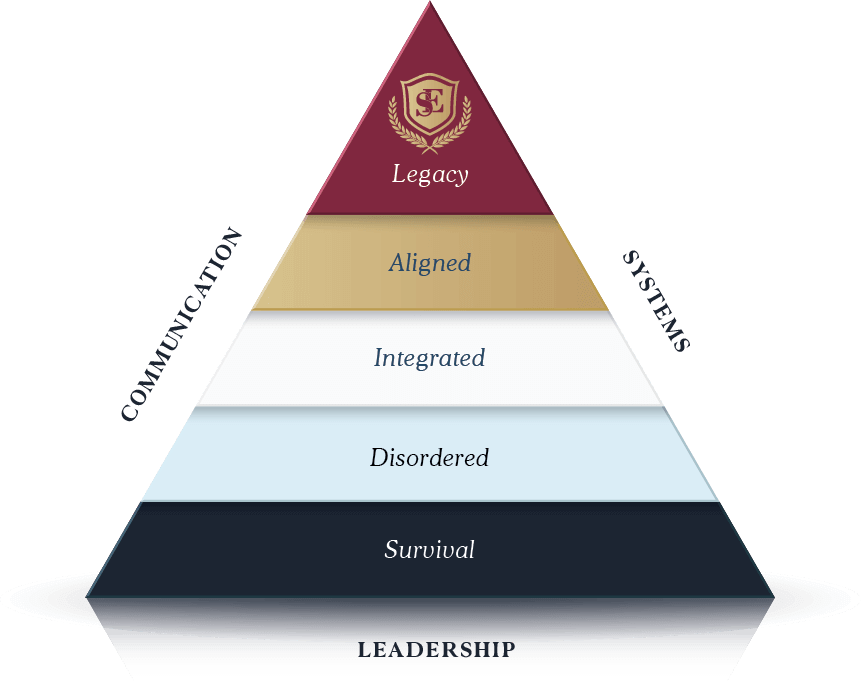1. Survival Stage
What It Looks Like: A lack of structure, organization, and processes in your center.
Questions You’re Dealing With: Where do I find qualified teachers? How do I convert prospects into clients? How do I market to ideal parents and understand their needs? How do I determine which processes to use? How do I cover payroll and overhead costs?
Focus On: Building (or rebuilding) a solid foundation and developing a clear vision for the future.
It’s easy to assume that only brand-new centers are in the Survival Stage. But this first stage has less to do with the age of your center and more to do with its internal organization. If your center has recently gone through a major transition or crisis, you could very well be back in Survival. (For example, pretty much every school went back to the Survival Stage right after COVID.)
If your center is in the Survival Stage, you’re probably wading through ambiguity while feeling a lot of self-doubt and uncertainty. You might feel desperate for answers—and you might risk looking for them from leaders who are in a different stage of growth than you are.
To make it through the Survival Stage, you’ll need to embrace the unknown while rolling up your sleeves. By answering the questions above, and transforming those answers into standardized processes, you’ll build the foundation that will allow your center to evolve and thrive throughout the next four stages of growth.
Stuck in Survival? The first 90 days of our Owner’s HQ and Director’s Inner Circle membership programs are dedicated to teaching you the tools and frameworks to get your center out of the Survival Stage. Apply today to see if you’re a fit.
2. Disordered Stage
What It Looks Like: The beginnings of growth and stabilization in your center after the chaos of the Survival Stage.
Questions You’re Dealing With: How can I stop my center from accumulating debt? How can I create referral programs and incentives? How should I answer questions from teachers and parents? What are the roles and responsibilities of my staff members?
Focus On: Stabilizing your operations, further developing systems and infrastructure, and building a strong team.
Going from the Survival Stage to the Disordered Stage is like going out of the frying pan and into the fire. Your center has experienced enough growth and development to get things moving, but your initial optimism and excitement have been replaced by the harsh realities of all the day-to-day minutiae of leadership.
For leaders, the Disordered Stage is marked by shame, guilt, and decision fatigue. “Should” is the most common word in your lexicon: “I should know what I’m doing.” “I should be better at this.” “This should feel easier.” All those “shoulds” pile up so much that you end up drowning in procrastination and self-doubt.
The way out of this cycle is by developing the infrastructure to make your center’s growth sustainable. That means systems: communications systems, gratitude systems, time management systems, and many more. I teach owners and directors exactly how to build and maintain these systems in my membership programs.
3. Integrated Stage
What It Looks Like: Your center has worked to build a solid foundation and is now growing rapidly.
Questions You’re Dealing With: How can I increase enrollment and improve education? What bottlenecks and operational inefficiencies are in my center? How can I delegate better? Who should I be delegating to? Which of my staff members have leadership potential? What community partnerships can I build?
Focus On: Increasing your center’s enrollment, improving academic performance, expanding your leadership team.
As the center of the Pyramid of Excellence™, the Integrated Stage is the longest stage for most school leaders. Your center might stay in the Integrated Stage for several years as you continue to build infrastructure and get strategic.
A major focus of the Integrated Stage is developing growth plans for your team. You’ve moved on from just trying to hire as many teachers as possible and can now actively invest in their skills. Integrated leaders work on structuring systems for one-on-ones, feedback, performance plans, and paths to promotions. (In the Owner’s HQ and Director’s Inner Circle memberships, we call this the Six Performance Keys: diagnostic tools to assess your staff’s performance.)
Be aware that there’s often a good amount of staff churn in the Integrated Stage. This is normal and even healthy—it means your team members are leveling up their skill sets and determining whether their goals and personalities align with the vision of your center.
4. Aligned Stage
What It Looks Like: Your center is well-established, and you’re looking for new opportunities for growth and development.
Questions You’re Dealing With: How can I maximize my center’s impact? Should I consider opening a second location? What new programs or initiatives could I work to develop? How can I create a sense of shared community and alignment with my center’s parents, teachers, and staff?
Focus On: Expanding your center’s reach, increasing the impact and imprint of your center, creating a culture of care and support, fostering continuous improvement and innovation.
Once your center reaches the Aligned Stage, you can finally start tackling the things you dreamed of doing when you were in the earlier stages: expanding your reach, creating new programs, and starting to establish not just a school, but a legacy.
Most leaders in the Aligned Stage accomplish this in one of two ways:
- Expansion. Opening a second (or third, or fourth) location is a terrific opportunity to improve your center’s reach and revenue. It’s also costly and time-consuming. Ask yourself: Do your infrastructure and resources support expansion? Do you have a solid enough foundation to build upon?
- Going deeper and stronger. There are plenty of ways you can increase your center’s impact without a new location. Improving your center’s quality of operations, enhancing your curriculum, investing in professional development for your staff, building strong community relationships, and nurturing your brand reputation can all lay powerful groundwork for the final stage of growth.
5. Legacy Stage
What It Looks Like: Your center has achieved its goals. You’ve made it!
Questions You’re Dealing With: Do I need to reevaluate my center’s vision? How can I continue sustaining the growth I’ve achieved? How can I strengthen my leadership team even further? What needs to happen for me to feel confident that my center will continue after I’m gone?
Focus On: Maintaining your center’s success, maintaining a sustainable business model, improving financial management, developing a succession plan.
The final stage of the Pyramid of Excellence™—the Legacy Stage—means you’ve accomplished what you set out to do as a school leader. You’ve created a name for yourself in the early childhood education space, and you have a steady flow of teachers who consider it a privilege to work at your center.
But while there’s plenty to celebrate at this stage, the worst mistake you can make is to get complacent just because you’ve reached the top of the pyramid. Specifically, you’ll need to keep your leadership team strong and your systems sustainable. This will prevent you from dropping all the way back into the Survival Stage when the next crisis rears its head.
In the Legacy Stage, you might also think about what your center will look like after you’re gone. That could mean working to understand the assets you’ve built, looking at new acquisitions, determining a succession plan, or even reevaluating your center’s mission and vision.



